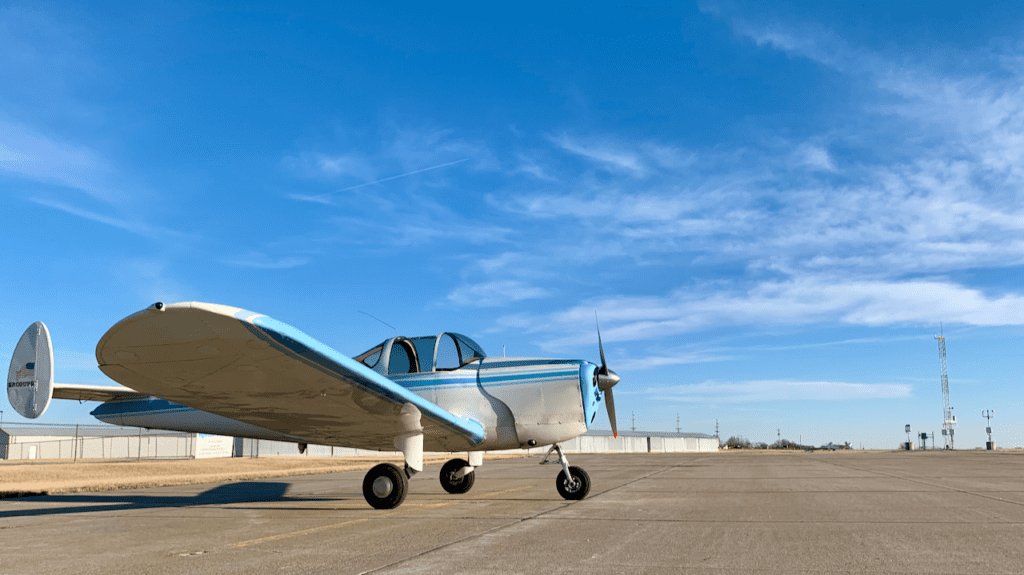Over the years, the Ercoupe has been a galvanizing topic amongst aviators. “It’s not a real airplane!”, “It doesn’t have rudder pedals!”, “Anyone who flies one of those isn’t a real pilot!” are phrases I’ve heard time and time again about this mysterious little airplane. I’ll freely admit that in the early days, I joined the naysayers. After all, I wanted to fly the fastest and most advanced airplanes I could get my hands on. But there was always something about the Ercoupe that fascinated me. Seeing it fly through the air, the H-tail reminded me of a B-25 bomber from World War II.
The Ercoupe was designed in 1938 by Fred Weick, an aviation pioneer ahead of his time. Weick was working for Engineering and Research Corporation (ERCO). Fred had already made significant advancements in aviation while working for NACA. But the Ercoupe was unique, and to this day remains the only certified ‘spin-proof’ standard type certificated aircraft. It also featured trailing link main gear, and had a steerable nosewheel. The Ercoupe was marketed as an airplane that anybody could fly. Production ground to a halt during World War II, but picked up again after. You could even buy an Ercoupe from Macy’s or Penneys! 1946 was the biggest production year, with demand dropping sharply after. Nearly 6,000 ‘Coupes were produced in total. Numbers from the FAA show around 900 registered Ercoupes in the United States. It’s unknown how many are flying today.
My first experience with a ‘Coupe occurred at my home airport of OXV. A local optometrist owned one, and I was entranced when I saw his Ercoupe flying. There wasn’t a spot of paint on it. He lovingly kept the aluminum polished to a high sheen. It seemed that every evening and weekend, he’d be out flying it. One day I had the opportunity to look inside the cockpit of his Ercoupe, and I was impressed. Besides maintaining the exterior, the interior looked like an art deco masterpiece, a throwback to a bygone area. In one word, it was cool.

Fast forward decades later. One listed for sale at my hometown airport of OXV. I had to see it and fly it. Actually, I flew two Ercoupes that day. I met ‘Fred’ the Ercoupe, and his owner Rodney, the local Ercoupe expert. Hint: If you need solid information on Ercoupes, Rodney is the man. He’s a walking, talking encyclopedia of experience on the Ercoupe. Within a week, the Ercoupe was mine. An added bonus (very important these days) was hangar space at the airport. It was where I had my first flight lesson in a Cessna 172 (at $23/hr wet), where my shirt was cut after I soloed, etc. It was as if life had turned full-circle. I took notice of the synchronicity.
Right off the bat, I experienced what I call ‘the Ercoupe bias’. I was now considered by some as an inferior pilot, “That other guy that flies an Ercoupe.” It had been a long time since I’d been home, and those fellows at the airport had no knowledge of my aviation background. I kept it that way for the longest time, flying the ‘Coupe often and spending time reminiscing with my friend Rodney. The jig was up though when I landed a Luscombe 8A taildragger on the field one day. That turned some heads!
With that said, I enjoy flying the Ercoupe. It’s snug on the inside, and unique in its own way, especially when landing in a crab during a strong crosswind. I explain to other pilots that it is the opposite of landing a tailwheel (conventional wheel) airplane.
I am detail-oriented and picky when it comes to maintenance. The first things replaced on the Ercoupe were practical. That included new battery, tires, swapping the Goodyear brakes for Clevelands, and a vertical speed indicator (VSI). Thankfully I have an A&P mechanic that understands flight safety is a priority of mine. Exterior embellishments don’t matter, but I want the aircraft maintained at a high level of safety. Has it cost money to service it? Yes, as the last annual included a propeller overhaul and generator replacement. But on the other hand I’m simply a caretaker of this small slice of aviation history, preserving it for future generations.
Love it or loathe it, you have to admit that an Ercoupe has a certain genius of design to it…Matt – aka This Old Pilot

The reason I don’t drop below 80mph on final is because the Ercoupe will develop a high sink rate at lower speeds. It’s a trap that many ‘Coupe pilots have experienced. Pull back the power, and she can sink like a rock. Get her sinking fast at an airspeed of 60mph or so, and your only remedy is full power while pushing the nose forward like in a stall recovery until you re-establish a positive rate of climb.
For example, one day I was practicing simulated engine outs. When established at a glide speed of 80mph, the sink rate was -1,000 feet per minute. At a glide speed of 75mph, the sink rate held at -1,250 feet per minute! When you consider those numbers, they are sobering. I’ll grant you that these results are from my Ercoupe only, yours may vary.

Due to the trailing link landing gear, landings in an Ercoupe are smooth. But if you’re holding a crab angle to cancel drift while landing in a crosswind, it will feel odd for the uninitiated. Seek out a flight instructor with Ercoupe experience to teach you the procedures and techniques required to safely land the Ercoupe in those conditions.
Many pilots have asked me if I’ve ever considered putting rudder pedals in my Ercoupe. The answer is no. I fly it the way it was designed to fly. I’ve seen ‘Coupes that had the rudder mod installed, then subsequently removed at considerable expense. My .02 worth: leave it alone. Fly the plane, and enjoy her. If I want to fly something with rudder pedals, I’m fortunate enough to have a Luscombe 8A in the stable.
The Ercoupe is a good airplane in my opinion, and fits a niche for many pilots. You simply need to know it’s quirks and make sure that you maintain it. I’ve had some passengers describe it “Like flying Grandma’s bathtub”, but that’s okay. I get to fly her. I get to see things that others do not. And.. I am a caretaker of aviation history for future generations that may one day appreciate the genius of Fred Weick.
Matt.. aka This Old Pilot

